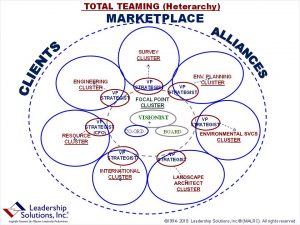by Peter A. Arthur-Smith, Leadership Solutions, Inc.®
“The brain is not organized hierarchically but rather as a heterarchical neuro-cognitive system.” One of the early essays on the differences between hierarchical and heterarchical systems by Warren S. McCulloch in 1945.
 |
Heterarchies are different animals to hierarchies and so it’s worthwhile comparing the two. Nothing seems to grow from the top down. People grow from the bottom up. Plants, trees and crops grow from the bottom-up, too. Buildings and towers do the same. Hamlets, villages, towns and cities grow from the inside-out. So why is it we’ve become so stuck on hierarchies? Is it because history has honored them as one of the more stable power structures – promoted by religions, monarchies, governments and armies?
But now we’re in the 21st century and it’s time to explore alternatives. Power has become increasingly more diffuse through democratization. Power centers are more in flux with increasingly diverse networks of communication. Workplace people seek more empowerment rather than be commanded-and-controlled. Maybe the time has come for utilizing heterarchies instead of hierarchies? After all, every system reaches the end of its useful life, as is happening with the current approach to manufacturing micro-chips.
Your writer is familiar with two types of people-organized heterarchies:
- A power-heterarchy, rather like the brain, where the focus is constantly shifting toward who has the resources, know-how and leadership talent to attract people’s followership – see “The Riddle of Heterarchy: Power Transitions in Cross-functional Teams” by Aime, Humphrey, DeRue and Paul -2014. John Naisbitt has also shared similar thoughts with his ‘Teal Organization.’
- A communal-market focused heterarchy, as per the one about to be described, is likely to be much more performance effective than traditional hierarchies. Its focus is around market opportunities or threats and how it adapts to take advantage of or avoid those two possibilities. It readily shifts its internal resources, organization and know-how to handle the situation. And so, instead of being focused on changing internal power-brokers, it is primarily focused on key external interests. It is orchestrated from the center outward rather than from above – see the below example. More importantly, it focuses the organization’s members on key areas outside the organization rather than politics on the inside.
 |
History has shown that all astute political leaders, who are experiencing discontent at “home,” focus their people on issues outside their borders in order to recapture their focus. So why shouldn’t leaders at large draw upon this reality? Why continue to batten-down on your people – ala managing them; when finding significant issues elsewhere of importance or concern to your workforce, can give you and your executives tremendous motivational advantage?
In this example, you can see the Visionist orchestrating from the center rather than at the apex. He/She is there with Board members and is focused outward, along with key Strategists and specific team clusters. These clusters will either have similar or diverse competencies dependent on their client serving role. They will also have Team Leaders to focus and encourage team contributors.
Wherever possible team contributors will work in pairs, since work-pairing has many advantages over individual performers. We will discuss this more in our next Phase 4 – Enlightened Teambuilding article. Such teams constantly feedback market observations; to be absorbed and acted upon by other clusters, Strategists, the Visionist and eventually by owners or Board members…all looking outward from the center.
Power-heterarchies can invite potential struggles and possible confusion, at least for a while, especially with those more used to hierarchies. A company like W.L. Gore & Associates – proprietor of well-known products like Gore-Tex – has successfully used such an approach for many years and has been viewed as more dynamic and profitable than most mainstream organizations. It has no formal titles and is known for empowering natural leaders to develop and promote products valuable to the marketplace. In this case, it is also known as a Teal organization.
Coming back to the communal-market focused – potentially named as a ComMark – organization, it has many of the advantages of a heterarchy (He) although also lightly uses some of the perceived benefits of a hierarchy (Hi) as below:
» Outward focus minimizes internal power struggles (He).
» Use of formal leadership roles – such as Team Leaders, Strategists and Visionist – brings organizational clarity (Hi).
» Gore-Tex’s (in top 100 listed companies as best place to work) role of Associate morphs into your Contributor, where workplace people are viewed as either High Contributors, Contributors or Non-Contributors – workplace people are available to contribute (He) rather than be employed (Hi).
» Outward focus naturally reminds people of their true primary purpose: To provide customers-clients-users-beneficiaries with an extraordinary experience. Done in an effective way, that balances customer and shareholder interests, it can only make the (He) organization that much more productive and robust.
» Allows contributors to feel more empowered and creative (He), versus a slave to protocol and hierarchy (Hi).
» Permits greater natural teamwork, as people collaborate to meet perceived market and customer needs (He).
The only thing preventing more companies taking this more empowering, creative and profitable approach with a ComMark organization is our inherent conservatism, preference for working with what’s familiar, and serving the interests of people who enjoy power. Our traditional approach is reinforced by managers who seek power, rather than leaders who offer empowerment. When will you be ready to offer greater people engagement through offering a ComMark-focused work environment?
Hierarchies don’t engage people; except those who seek power.
Heterarchies will engage people; because they’re primarily focused on customer-market needs – that is, natural entities requiring attention outside of those people’s organizations.
To learn more about workplace people engagement, talk with:
